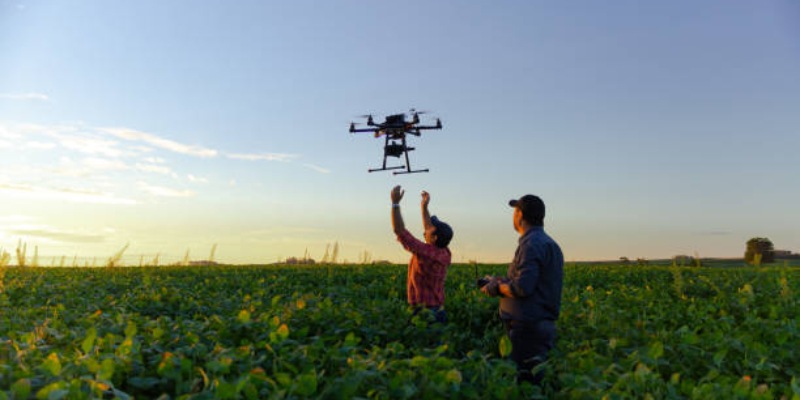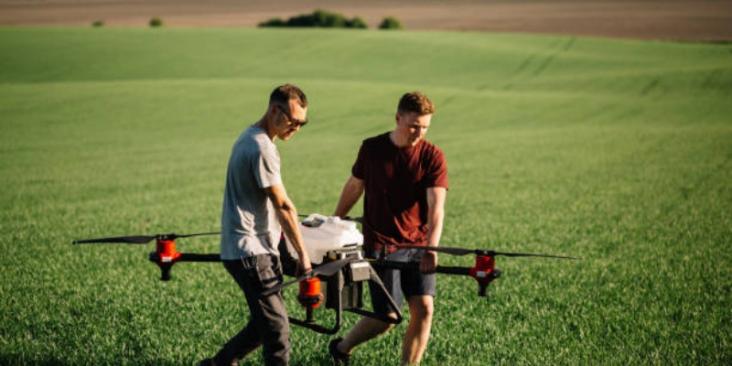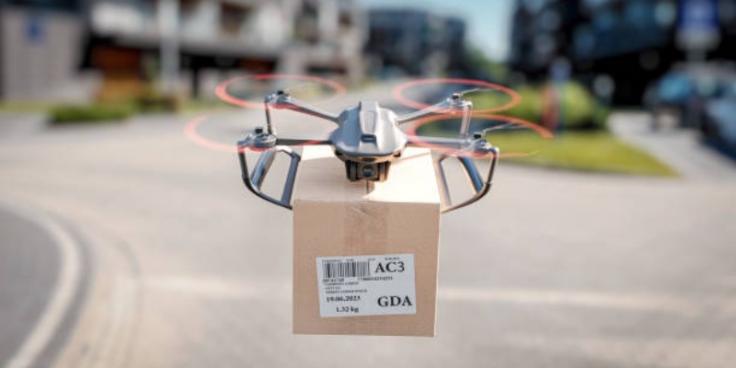A Beginner’s Guide To Drones: What You Need To Know
Drones are flying robots that can do many things. Some are small and light, and others are big and strong. They can shoot photos, assist farmers in growing crops, or even drop off packages. This guide will help first-time users understand the fundamentals of drones. It lays out these things, how they work, and how to choose a good one.
What Is a Drone?
A drone is an aircraft that doesn't have a human pilot aboard. It can fly on its own or be operated from the ground. (These machines are uncrewed aerial vehicles, or UAVs.) Drones have many uses. Some people use them for fun, and others for work. Drones can soar into the sky and snap photos or film videos from up high. This can be useful for photographers, farmers, and rescue teams, to name just a few.

Parts Of a Drone
Every drone has parts that help it fly and work properly. Here are the main ones:
Frame: The body of the drone. It holds everything together.
Motors: They spin the blades so the drone can fly.
Propellers: These spinning blades lift the drone into the air.
Battery: Gives power to the drone so it can move and fly.
Flight Controller: Acts like the brain of the drone. It tells the motors what to do.
GPS Module: Helps the drone know where it is. This can make it easier to fly and land.
Camera: Not all drones have cameras, but many do. This lets them take photos or videos from the sky.
Knowing these parts helps users understand how drones work. It also helps when picking the right one or fixing problems.
Common Uses For Drones
Drones can do many things. Here are some popular uses:
Photography and Video: Many people use drones to take pictures or videos from above. This gives a unique view that is hard to get from the ground.
Agriculture: Farmers use drones to check on crops. They can see if plants need water or if there are pests.
Delivery Services: Some companies use drones to deliver small packages. This is faster than driving in some areas.
Search and Rescue: Drones help find missing people. They can fly over rough terrain and send rescuers live video.
Racing: Drone racing is a sport in which people race fast drones through courses.
These examples show how drones can be helpful in many fields.
Choosing The Right Drone
Picking the best drone depends on what the user wants to do. Here are key things to think about:
Budget
Drones come in many prices. Some are under $100. Others cost thousands. New users may start with a cheaper model. This lets them learn without spending too much money.
Purpose
What will the drone be used for? A camera drone is needed to take photos. A fast and agile model is better for racing. Some drones are made for beginners, and others are for experts.
Size And Portability
Some drones are small and easy to carry, while others are large and require a backpack. Consider where the drone will be used. Small ones are good for parks or cities, while big ones might be better for open fields.
Flight Time
Most drones can fly for 10 to 30 minutes on one battery. Longer flight times mean more time in the air. But they often cost more.
Range
Range is how far the drone can fly from the controller. Short-range drones are fine for beginners, while long-range ones are for advanced users.
Camera Quality
If you want to take photos or videos, check the camera specs. Some drones have basic cameras, while others can shoot 4K or higher.
Safety Features
Look for drones with GPS, obstacle avoidance, and auto-return. These features help prevent crashes and drone loss.

Learning To Fly
Flying a drone takes practice. Here’s how to start:
Step 1: Read The Manual
The manual contains essential information about using the drone safely. It also explains how to charge the battery and connect the controller.
Step 2: Practice In An Open Area
Begin in a vast space with few trees or buildings—a park or empty field is perfect. At first, avoid flying near people or animals.
Step 3: Start With Basic Moves
Learn how to take off, land, and hover. Then try moving forward, backwards, and side to side. Once these are easy, try turning and flying in circles.
Step 4: Use Training Modes
Many drones have training modes. These limit speed and height. They make learning safer.
Step 5: Watch Online Tutorials
Videos on YouTube or other sites can teach new skills. They show how to fly better and avoid common mistakes.
Rules And Regulations
Drones must follow laws to keep the skies safe. The Federal Aviation Administration (FAA) makes the rules in the United States. Here are some key points:
Register the Drone: Drones over 0.55 pounds must be registered with the FAA.
Fly Below 400 Feet: This keeps drones away from aeroplanes.
Stay Within Sight: The drone should always be visible to the pilot.
Avoid Airports: Flying near airports is dangerous and illegal.
Respect Privacy: Don’t fly over private property without permission.
Breaking these rules can lead to fines or other penalties. Always check local laws before flying.
Common Mistakes To Avoid
New pilots often make these errors:
Flying Too Far: Going beyond the controller’s range can cause the drone to crash or get lost.
Ignoring Weather: Wind, rain, or snow can make flying complex or dangerous.
Not Charging the Battery: Flying with a low battery can cause the drone to fall.
Rushing Takeoff: Take time to check the drone and surroundings before flying.
Learning from these mistakes helps users become better pilots.
Drone Maintenance Tips
Drones need care to last long. Here’s how to keep them in good shape:
Clean After Flights: Wipe off dirt and dust. Check propellers for cracks.
Check Connections: Make sure all parts are secure. Loose wires can cause problems.
Store Batteries Safely: Keep batteries in a cool, dry place. Charge them before long-term storage.
Update Software: Manufacturers often release updates. These fix bugs and improve performance.
Regular maintenance prevents issues and keeps flights smooth.
Upgrading Your Drone
As skills grow, users might want to upgrade. Here are ways to improve a drone:
Better Camera: Swap out the camera for a higher-quality one.
Extra Batteries: More batteries mean longer flying time.
Obstacle Sensors: Add sensors to help avoid crashes.
Longer Range Antenna: This lets the drone fly farther.
Upgrades can make a drone more fun and valuable.
Joining The Drone Community
Many people enjoy drones as a hobby. Joining a community can help new users learn and share. Here’s how to connect:
Online Forums: Sites like Reddit or specialised drone forums have tips and advice.
Local Clubs: Some areas have drone clubs. Members share knowledge and organise events.
Social Media Groups: Facebook or Instagram groups often post drone photos and tips.
Being part of a community makes learning easier and more fun.

Finding Your Drone Community
Connecting with other drone lovers can help beginners grow their skills. Local clubs and online groups are great places to start. Many areas have events where drone pilots gather to fly and share tips. These events are fun and offer chances to meet experts. Online forums also let users ask questions and learn from others’ experiences.
Getting Help With Drone Regulations
Understanding the rules for flying drones is essential. The FAA website has clear guidelines for beginners. Local hobby shops or clubs can also advise on where to fly safely. Checking these resources helps pilots avoid trouble and stay informed.
Exploring Advanced Drone Skills
Once the basics are mastered, users can try new challenges. The following steps are flying in windy conditions or using manual controls. Some pilots learn to edit drone videos or take aerial photos. Others compete in races or use drones to map land. These skills open up more ways to enjoy drones.
Staying Safe While Flying
Safety should always come first. Here are tips to keep flying fun:
Check the weather before flying.
Avoid flying near people or animals.
Keep the drone in sight at all times.
Learn emergency landing steps in case of trouble.
Following these steps helps prevent accidents and keeps everyone safe.
Making The Most Of Your Drone
Drones are tools for creativity and exploration. They let users see the world from a new angle. Whether taking photos, helping with work, or racing friends, drones offer endless possibilities. With practice and patience, anyone can learn to fly and enjoy these fantastic machines.
Learning From Mistakes
Even experienced pilots make errors. The key is to learn from them. Keeping a flight log can help track progress and note lessons learned. Reviewing past flights shows what went well and what needs improvement.
Keeping Your Drone Ready
Regular checkups ensure the drone works when needed. Before each flight, inspect propellers, battery levels, and connections. A quick pre-flight checklist helps avoid last-minute issues.
Enjoying The Journey
Flying drones is a rewarding hobby. It combines technology, creativity, and adventure. By starting small, practising often, and staying curious, beginners can become skilled pilots. The sky is the limit for what drones can do.